By: Alexander J. Taylor
For me, there is nothing better than an Autumn day. The air is cool, but not yet snowing; the chance to wear hoodies and jeans, and not be stifling hot; and the consistent sounds of popping lids of freshly canned foods. Yes, I truly do mean that, the sound of popping lids after a long day of canning, pickling, and cooking. In my family, and now on my own, it is a tradition that near the end of Summer and the start of Fall, that we are constantly pickling and canning a variety of foods. Sauerkraut, jalapeños, pickles, and carrots have all been made, recipe-tested, and eventually eaten as delicious sides or toppings with fall-themed meals. As a child, I did not really know much about the process of pickling, but now I truly know what produced that tart, crisp, and vinegary vegetable was actually fermentation.
Fermentation has been a huge, hot topic in the recent decade due to its effect on the gut health and microbiome of humans. Not only food products, but fermented drink products are booming as a trend. From kombucha to kefir, to the local microbreweries and wineries, consumers have fallen in love with fermented foods and drinks. Chefs, culinary experts, and brewers have also taken up the mantle of experimenting with various types of fermented ingredients to add to their dishes and drinks. While many know the popular fermented products, (pickles, sauerkraut, kimchi, beer, etc.) the process of fermentation is largely unknown to the average consumer. Typically the descriptive word “fermented” has been associated with negative connotations like “overripe,” “moldy”, “pungent,” or “old.” However, these descriptors could not be further from the truth. So let us take a look at what fermentation is, some products that are fermented (which might surprise you!), and why I encourage you to ferment at home!
So let’s start at the beginning…
Which would be around 12,000 years ago, in China, in the Neolithic era. There is evidence from multiple pottery jars in the Henan province of China that showed mixed fermented beverages of rice, honey, and some fruits. This is the earliest case of known fermentation, but likely it was used before then! Fermentation was used as a preservation technique so that foods and drinks could be stored over a long winter. Kimchi, Korea’s national food, was typically stored in pottery, sealed, and placed in the cool, Autumn ground to store vegetables for the Winter. Sauerkraut, a similar German side dish (actually it is a Chinese dish that was brought to Europe) was used on long sea-voyages as a way to prevent scurvy, as the fermentation process makes Vitamin C in the sauerkraut. Some cultures even attributed deities to aspects of wine, fermentation, and alcohol, such as Dionysus, the Greek god of wine, Osiris, the Egyptian god of beer and wine (speaking of Egypt, check out this AMAZING thing where they used a 5,000-year-old yeast to make beer and bread), Bacchus, the Roman god of wine, and a long list of many more. Christianity and Judaism have specific religious symbols attributed to fermentation (types of bread and wine). Even the great delicacy that is chocolate is made thanks to fermentation! No matter where you go in the world, you will find a product that has been made possible, thanks to fermentation.
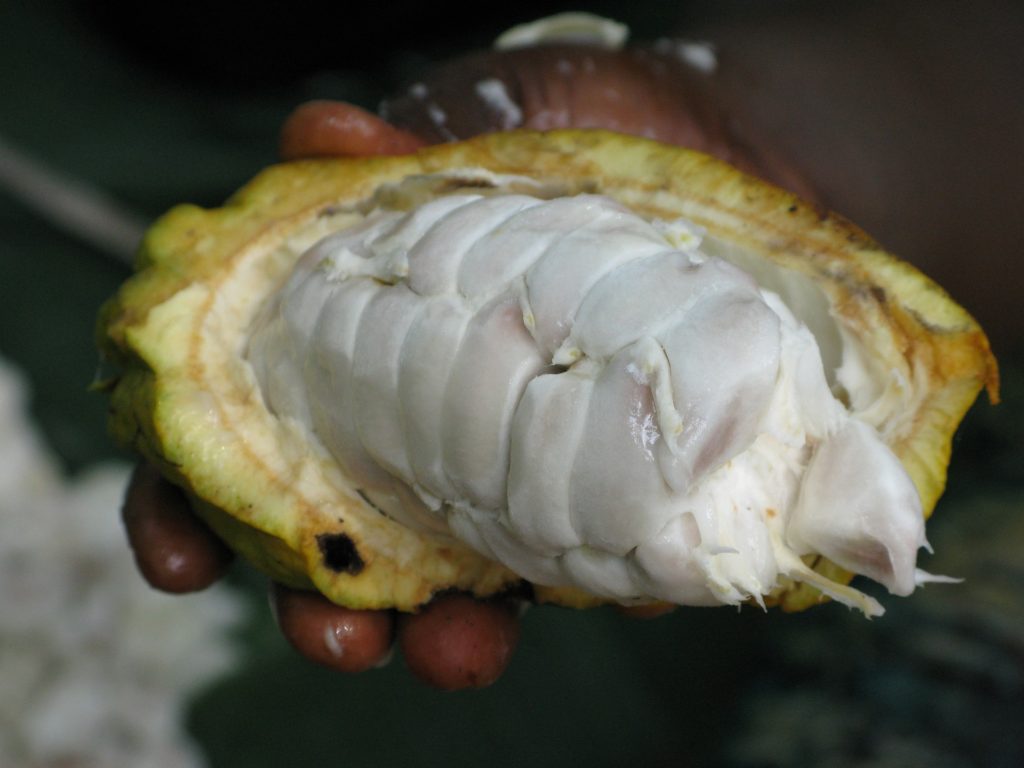
Cocoa Pod – Image by David Greenwood-Haigh from Pixabay
But why is that? How can something be so universal and well accepted, but have slight differences? While dishes have cultural influences and differences, there may be a smaller, more microscopic influence in local microorganisms. Microorganisms like yeasts, molds, and bacteria break down compounds like sugar, proteins, etc. to make ethanol, water, carbon dioxide, and other organic compounds. There are a vast number of yeasts, molds, and bacteria associated with fermentation and each has its own specific wants, needs, and end-products. However, it wasn’t until the mid-1800s, when a scientist, Louis Pasteur, linked yeasts (and later on, other microorganisms) to fermentation. So when someone was fermenting and preserving their foods, the only microorganisms they had were the ones that were local to them. These local microbes (a shorter version of microorganisms) could vary from region-to-region and produce different flavor-associated compounds.
Likely you have heard of the terms prebiotic and probiotic, and may think they are interchangeable. However, there’s an important difference between the two. Prebiotics are carbohydrates that humans cannot digest, but our gut microbiome can; typically, complex carbohydrates or foods high in dietary fiber contain prebiotics. Probiotics are products that actually contain live and active cultures of bacteria, like yogurt, sauerkraut, and kimchi. Both serve the purpose of helping your gut microbiome by either feeding it or helping to diversify it. This process aids with digestion and gut health, with more research constantly coming out on possible effects of both on our health. Some studies have stated prebiotics can help with calcium and mineral absorption, others have said that probiotics can help with metabolism and weight loss. However, it simply comes down to having a diverse diet of fruits, vegetables, complex carbs, and other foods. As a quick aside, this is not an advocacy to take supplements for pre- or probiotics! Just eat some fruits and veggies!

Kimchi – Image by Dongtan Ko from Pixabay
So now we know what fermentation is, how it works in a simplistic manner, and why it is important. But why is it so popular right now? Well, there is a two-pronged answer to that. First, gut microbiome research has been constantly improving and secondly, consumers want healthy and “strange” foods. On the gut microbiome side, researchers have been able to create experiments that focus on knowing what exactly is going on in our digestive systems. An important tool, known as whole genome sequencing or WGS, has become relatively inexpensive in recent years. This tool allows for clear identification and characterization of the diversity, number, and amount of microbes in our gut, as well as explores their genetic makeup. That means researchers can see what proteins and compounds are being made by our gut microbiome and how they react to different treatments (diets). While this research is exciting, there are endless possibilities for gut microbiome work, and we only have scratched the surface.
One group of researchers has created a multi-compartmental model to simulate the conditions of the GI-tract from start to finish, using the researchers’ own gut microbiota. Yes, researchers have created a machine that can take in food, digests it, and then farts and poops it out… I’m not joking here. This machine is one of the most advanced models we have available. However, it is still just that, a model. Dr. Hannah Holscher is one such researcher, here at the University of Illinois at Urbana-Champaign, who is looking at different foods and their impacts on the gut microbiome, such as walnuts, almonds, avocados, the Mediterranean diet, and broccoli . Even with this topic exploding, researchers are constantly finding that the gut microbiome is incredibly important to human health.
As for consumers, there have been recent trends to find new, bold, and interesting flavors from food. Chefs have been adding pickled vegetables, different cheeses, and acidic sauces like fish sauce, kinds of vinegar, etc. Every year at IFT’s annual meeting, Land O’ Lakes puts up a main display of trending flavors for the next year. This past year had highlights like caramel, cinnamon, hatch chili and other peppers; but what struck me was the amount of fermentation-based flavors. Gochujang, bleu cheese, white cheddar, fried pickles, bourbon, tzatziki, and the multiple other “funky” types of cheese like Asiago, Swiss, and Pimento (There’s a lot of cheese on here…).
There has also been an exploding market in Kefir, Kombucha, and other shelf-stable probiotic foods. More and more plant-based foods, snacks, and products are coming out. Consumers are focusing on innovative new ways to find “natural” and I would argue that there isn’t a more natural processing method than fermentation!
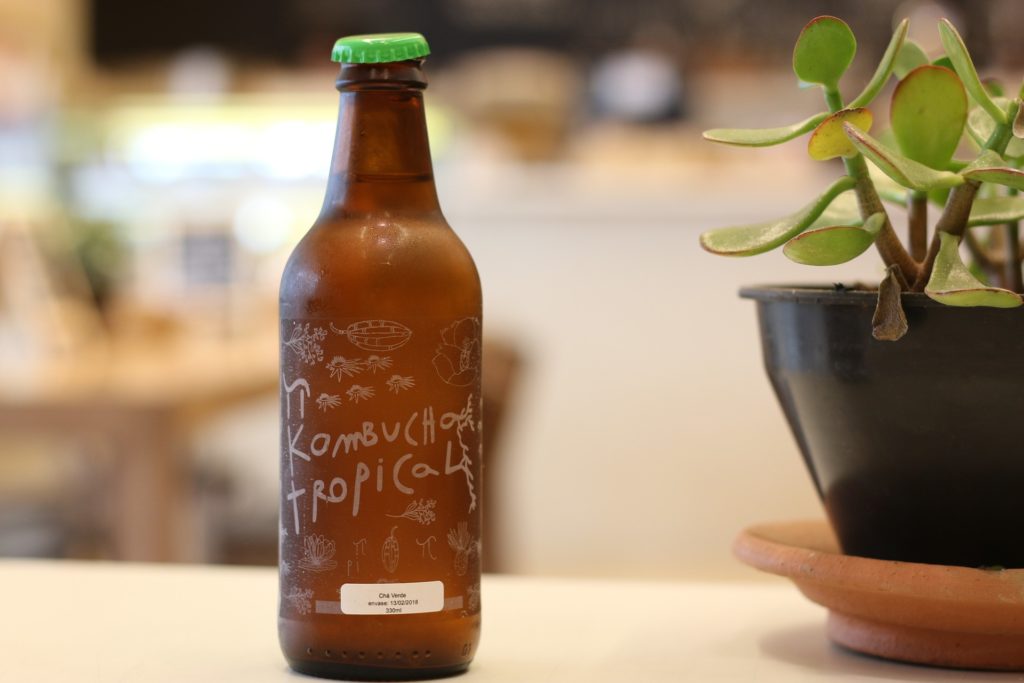
Kombucha – Image by LyraSid from Pixabay
So, how can you ferment something at home?
Well, there are a variety of ways and it can be a great hobby to have. First off, you need to choose what you want to ferment or what to make. The internet is a wide-sea of knowledge for what to ferment, but I would always say to start at the easy ones and then maneuver from there. You can move onto more complicated recipes and do whatever your heart desires, but I will say that now is the perfect time for some delicious pickled vegetables! Buy some glass jars with lids, buy some of your favorite veggies (cucumbers are a good starter), cut them into whatever shape you want (I like thin chips for my pickles). If you are using cucumbers, salt them and add some fresh ginger slices, toss and leave for 30-45 minutes to drain water; if they bend without breaking, they are good. Boil equal parts water and vinegar (I like apple cider vinegar) with aromatic herbs, spices, and seeds (cumin seeds, mustard seeds, ginger, garlic, dill, etc.). This next step is very important, as you can contaminate your jars and lose your fermentations. Bring another, medium-sized (big enough to fit one of your jars) pot of water to a boil. Once boiling, add your lids and seals to the bottom and bring it down to a simmer and let it calm down for a bit (~5-7 minutes). The order will be like this:
- Place a jar and a funnel into the water, fully submerged for 10 minutes
- Pour the water into the pot, place the jar onto a clean towel
- Using tongs load your jar with your cucumbers leaving some space, but not a lot
- Pour your hot pickling liquid (using the sterilized funnel) into the filled jars, filling to the top
- Using tongs, grab a lid and the seal, and place the lid onto the top of the filled jar
- Using a clean towel, screw the seal onto the lid until tight
- Write the date, product, and anything else on the top of the lid and let cool (you’ll hear those pops I mentioned as the jars cool down)
- Repeat until all of your cucumbers are used up, jars are filled, or the pickling liquid is out!
- Let the finished jars sit out until you don’t hear any pops and then you can do one of two things:
A. Ferment on your counter-top, in a cool location, for 5 days and then put in your fridge
B. Put them into your fridge to ferment for 2 weeks and then consume!
Once you open them up, you’ll likely have about 2-3 weeks, refrigerated, for them to be eaten, but as always, use your best knowledge. If the liquid turns cloudy, do NOT use them; dispose of immediately. Also look for bumps on the top of your lids, as this means the jar was contaminated in the process. Feel free to follow this recipe from The Kitchn on how they pickle!
At the end of the day, fermenting food used to be just a way to preserve food, but has become a growing “culture-al” – sorry, I couldn’t resist that pun – movement that you can find everywhere. Go out and try something new and fermented – buy that kombucha, add some pickled slaw on your burger, or smother bleu cheese butter on your steak. No matter what you try, I hope that you’ll think of the phenomenal, interesting, and bold flavors and the microbes that made them. Then maybe, just maybe you’ll be frothing at the bit to make your own fermented products.
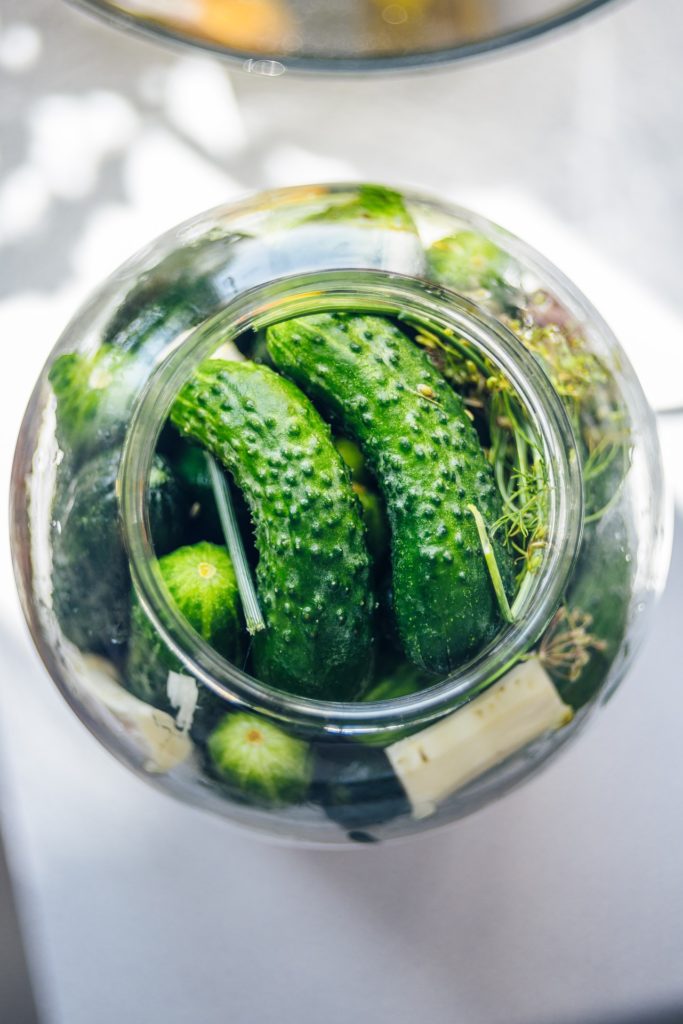
Pickled Cucumbers – Image by Kasjan Farbisz from Pixabay
Did you enjoy this article about fermentation? Come check out our Instagram and Facebook to get plugged into more articles about the science of food!

A.J. Taylor | Linkedin
A.J. earned his degree in Biochemistry from Judson University and his Master’s in Food Science and Human Nutrition from the University of Illinois at Urbana-Champaign. His research then focused on Listeria monocytogenes, but has now transitioned into a Ph.D. program at UIUC in the hopes to discover more about the cocoa bean fermentation process using genomic, bioinformatic, and biochemical tools to define chocolate flavor from start to finish. A.J. emphasizes on the importance of science communication and loves to discuss multiple topics in the Food Science realm. A.J. is also an avid gamer from board games to video games, as well as a podcast-lover, if you have any recommendations, he is all ears!



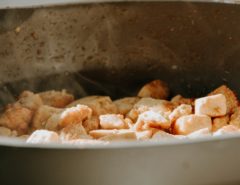

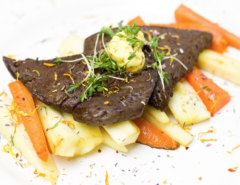
Leave a Reply